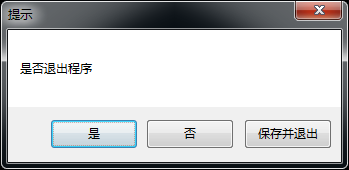运行效果:
代码:
using System; using System.Drawing; using System.Runtime.InteropServices; using System.Text; using System.Windows.Forms; namespace Sphinx.Utils { public class MessageBoxEx { public static DialogResult Show(string text, string caption, MessageBoxButtons buttons, string[] buttonTitles) { MessageForm frm = new MessageForm(buttons, buttonTitles); frm.Show(); frm.WatchForActivate = true; DialogResult result = MessageBox.Show(frm, text, caption, buttons); frm.Close(); return result; } public static DialogResult Show(string text, string caption, MessageBoxButtons buttons, MessageBoxIcon icon, MessageBoxDefaultButton defaultButton, string[] buttonTitles) { MessageForm frm = new MessageForm(buttons, buttonTitles); frm.Show(); frm.WatchForActivate = true; DialogResult result = MessageBox.Show(frm, text, caption, buttons, icon, defaultButton); frm.Close(); return result; } class MessageForm : Form { IntPtr _handle; MessageBoxButtons _buttons; string[] _buttonTitles = null; bool _watchForActivate = false; public bool WatchForActivate { get { return _watchForActivate; } set { _watchForActivate = value; } } public MessageForm(MessageBoxButtons buttons, string[] buttonTitles) { _buttons = buttons; _buttonTitles = buttonTitles; // Hide self form, and don't show self form in task bar. this.Text = ""; this.StartPosition = FormStartPosition.CenterScreen; this.Location = new Point(-32000, -32000); this.ShowInTaskbar = false; } protected override void OnShown(EventArgs e) { base.OnShown(e); // Hide self form, don't show self form even in task list. NativeWin32API.SetWindowPos(this.Handle, IntPtr.Zero, 0, 0, 0, 0, 659); } protected override void WndProc(ref System.Windows.Forms.Message m) { if (_watchForActivate && m.Msg == 0x0006) { _watchForActivate = false; _handle = m.LParam; CheckMsgbox(); } base.WndProc(ref m); } private void CheckMsgbox() { if (_buttonTitles == null || _buttonTitles.Length == 0) return; // Button title index int buttonTitleIndex = 0; // Get the handle of control in current window. IntPtr h = NativeWin32API.GetWindow(_handle, GW_CHILD); // Set those custom titles to the three buttons(Default title are: Yes, No and Cancle). while (h != IntPtr.Zero) { if (NativeWin32API.GetWindowClassName(h).Equals("Button")) { if (_buttonTitles.Length > buttonTitleIndex) { // Changes the text of the specified window's title bar (if it has one). // If the specified window is a control, the text of the control is changed. // However, SetWindowText cannot change the text of a control in another application. NativeWin32API.SetWindowText(h, _buttonTitles[buttonTitleIndex]); buttonTitleIndex++; } } // Get the handle of next control in current window. h = NativeWin32API.GetWindow(h, GW_HWNDNEXT); } } } public const int GW_CHILD = 5; public const int GW_HWNDNEXT = 2; public class NativeWin32API { [DllImport("user32.dll", CharSet = CharSet.Auto)] public static extern bool SetWindowPos(IntPtr hWnd, IntPtr hWndInsertAfter, int x, int y, int Width, int Height, int flags); [DllImport("user32.dll")] public static extern IntPtr GetWindow(IntPtr hWnd, Int32 wCmd); [DllImport("user32.dll")] public static extern bool SetWindowText(IntPtr hWnd, string lpString); [DllImport("user32.dll")] public static extern int GetClassNameW(IntPtr hWnd, [MarshalAs(UnmanagedType.LPWStr)]StringBuilder lpString, int nMaxCount); public static string GetWindowClassName(IntPtr handle) { StringBuilder sb = new StringBuilder(256); // Retrieves the name of the class to which the specified window belongs GetClassNameW(handle, sb, sb.Capacity); return sb.ToString(); } } } }
